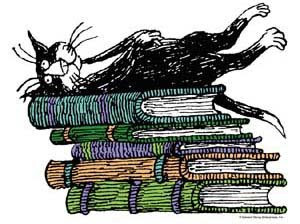When reading through Gorey’s Amphigorey: Fifteen Books, I noted how the fonts change from story to story, and how they indicate whether the particular section will be an intense and scary or a whimsical and funny.
For example, “Bug Book” is very childlike in its simplicity and charm. The font Gory uses follows suit, it has an innocence about it and almost looks like the handwriting of an adolescent (see below).
. 
In contrast, I found “The Hapless Child” to be utterly terrifying and depressing, not at all fit for a child’s bedtime story. The font in this story is a gothic-style script that conveys a sort of melancholy and dramatic feeling (see below).

One more example is from “The Curious Sofa”. This story was quite erotic and bizarre, and I found that the font really fit with the themes. There is also something very playful about the way the letters curl at the ends that tells the reader to not take the story very seriously.

Examining Gorey’s font choice can provide insights into his intentions of the story and its meaning. It also shows the variety that Gorey is capable of–covering everything from an innocent children’s story about the teamwork of bugs to the horrifying death of a child to a pornographic story all in the span of thirty pages!




